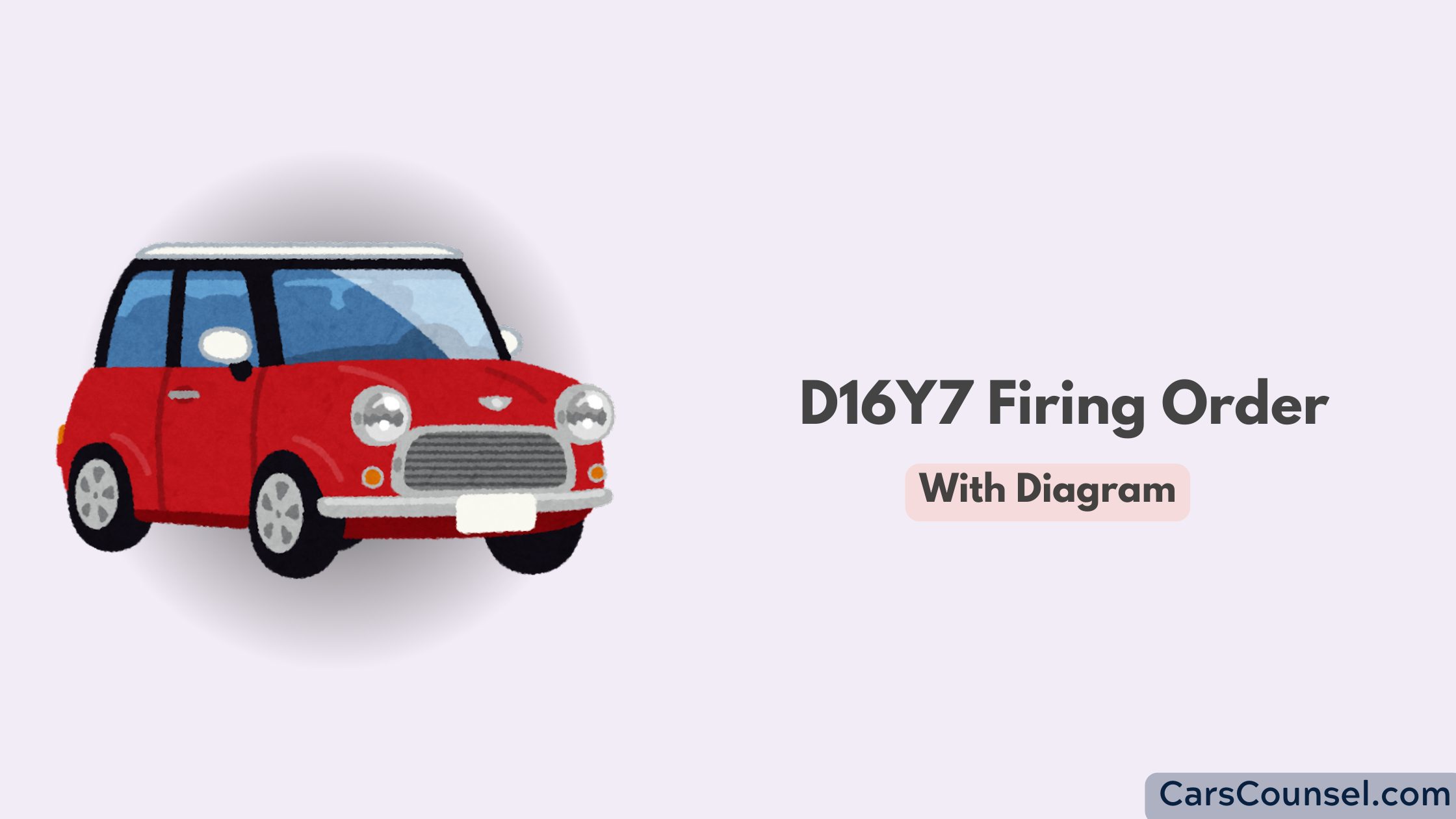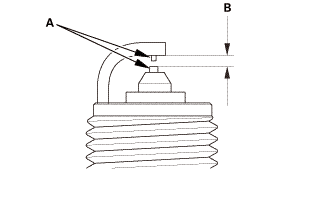The firing order for a D16Y7 engine is 1-3-4-2. This means the engine sparks the cylinders in that order for the best performance and fuel use. Wrong wiring can cause the engine to not work as well, so you should make sure the wires on your distributor cap are connected correctly.

If your engine is misfiring or if your On-Board Diagnostics system is showing fault codes, you might have a problem. Knowing the order in which your engine fires the cylinders is important for keeping your engine working well.
Read on to learn more about firing orders and how to take care of your engine.
Quick Navigation
Key Takeaways
- The D16Y7 engine, found in many Honda cars, fires in a specific sequence: 1-3-4-2. This order helps the engine run smoothly and efficiently.
- If the wiring isn’t set up to follow this order, the engine might not work as well and could use more fuel.
- To check the firing order, find the first cylinder on the distributor cap and trace the sequence 1-3-4-2 in a counterclockwise direction.
- This engine, which produces between 105 and 107 horsepower, uses a single camshaft and has four valves in each cylinder. This setup helps each spark plug fire efficiently.
- Regularly checking the timing of the ignition and the condition of the spark plugs can help keep the firing order correct and avoid problems with the engine.
Understanding the Firing Order

To make sure your D16Y7 engine runs smoothly, you need to correctly follow the order in which the spark plugs fire, starting with the one in cylinder 1. This firing order, which is 1-3-4-2, is really important to keep your engine running at its best.
After the spark plug in cylinder 1 fires, the next one to fire is in cylinder 3, then 4, and finally 2. Following this order helps to avoid problems with your engine and helps it use fuel efficiently.
It’s also really important to correctly connect the wires to the distributor. Even a small mistake can mess up the firing order and cause your engine to run poorly.
Don’t forget, your D16Y7 engine needs the correct firing order to run smoothly. Always double-check your firing order and the arrangement of your cylinders to keep your engine in top condition.
Applicable Honda Models
Interestingly, the firing sequence of 1-3-4-2 is not just for the D16Y7 engine, but also for other Honda models like D14, D15, and D17. This order of cylinder firing makes sure your Honda engine runs smoothly and effectively.
Here’s a simple comparison:
| Engine Model | Firing Sequence |
|---|---|
| D16Y7 | 1-3-4-2 |
| D14 | 1-3-4-2 |
| D15 | 1-3-4-2 |
| D17 | 1-3-4-2 |
This chart shows these Honda models have the same firing sequence. It’s important to follow this order when fixing or checking your engine. Sticking to the correct firing order can prevent issues like misfires and improve the performance of your engine.
Specifying Torque Details
Knowing the specific torque values for the different parts of your D16Y7 engine is necessary for putting it together correctly and getting the best performance out of it. These torque values are also important to make sure your engine lasts long and works reliably.
Here are the essential torque values for the D16Y7 engine:
- The bolts on the cylinder head: first tighten to 14 foot-pounds, then to 44 foot-pounds, and finally turn it another half circle
- The bolts on the main bearing cap: first tighten to 16 foot-pounds, then to 41 foot-pounds
- The nuts on the connecting rod cap: first tighten to 14 foot-pounds, then turn it a quarter circle
- The bolts on the flywheel: tighten to 56 foot-pounds
- The nuts on the intake manifold: tighten to 17 foot-pounds
Keeping these values in mind is a very important part of taking care of your engine. If you have any problems, look at your engine performance guide or troubleshooting manual.
Firing Order in Similar Vehicles
Besides the D16Y7, other cars like the 2020 Honda Civic, Audi A4, Kia Stinger, Toyota Camry, and Mazda3 all have the same firing order of 1-3-4-2.
When we compare these cars, we see they use the same method to control the order in which their engine fires. This isn’t random or something you can swap around. It’s a specific order that helps the engine run smoothly, reduces shaking, and makes the power spread out evenly.
If you misunderstand this, you might get the wrong idea about how the engine works and how to look after it. So, it’s really important to know the firing order and what it means for how the engine works in different, but similar, cars.
Checking Spark Plug Order
Making sure the spark plugs in your Honda D16Y7 engine fire in the right order is really important. It helps your engine work well and without trouble. This task might involve figuring out some spark plug issues and could mean you have to do some rewiring.
Here’s what you can do:
- Start by finding the first cylinder on the distributor cap.
- Follow the firing order (1-3-4-2) in a counterclockwise direction.
- Make sure the wires are hooked up to the right spots on the distributor cap.
- Look for any signs that the spark plug wires are worn out or damaged. If they are, replace them.
- Try starting the engine. If you’re still having trouble getting the engine to start, there might be a problem with the distributor. You’ll need to check it out more.
Decoding Engine Misfire Codes
If your D16Y7 engine isn’t working right and is making odd sounds, a device called the OBD-II analyzer can help you understand what’s going wrong. This tool is very important when trying to fix engine problems because it gives you specific codes that tell you about different issues.
For example, a P0300 code means that your engine isn’t working right in more than one part. The exact problem could be different each time, but it’s usually because of issues with the spark plugs, ignition coils, or fuel injectors.
Don’t ignore these codes. Use them to help you figure out what’s wrong. A step-by-step approach, like checking the spark plugs, testing the ignition coils, and looking at the fuel injectors, can help you find the problem. Remember, figuring out the problem correctly leads to finding the best solution, keeping your engine working well.
Ignition Timings Role
Getting the timing right in your D16Y7 engine is important because it affects how the engine works and performs. If the timing is spot on, your engine runs better and more efficiently.
Here’s what you need to know about timing:
- Timing is about deciding when the spark plug should ignite based on the piston’s position.
- If the timing is just right, your engine will perform better, use less fuel, and last longer.
- If the timing is off, your engine mightn’t be as powerful, use more fuel, and even get damaged.
- To adjust the timing, you’ll need a special tool called a timing light and some knowledge about the engine’s ignition system.
- Regularly checking and maintaining the timing can help your engine perform better.
Capabilities of D16Y7 Engine
When talking about the D16Y7 engine, it’s good to know that it can produce between 105 and 107 horsepower and a pulling power of 102 to 104 pound-feet. This engine has one camshaft on top and four valves in each cylinder, which helps it work at its best.
It also has a system called OBD-II that helps it meet emission control standards, meaning it doesn’t pollute as much. The engine has a system that injects fuel at multiple points, which helps it use fuel better and perform well. Even though it’s not heavy, it’s still dependable and doesn’t cost too much to run.
In short, the D16Y7 engine is a great mix of power, fuel-saving, and trustworthiness, making it one of the best in its range.
Conclusion
In conclusion, understanding the right setup of your car’s cylinders is important for the continued performance of your D16Y7. The correct positioning of plugs, proper methods of applying torque, and knowing the distinct sounds of the engine contribute to its overall usability.
It’s crucial not to overlook the importance of knowing your Honda’s firing order, which is 1-3-4-2. By understanding how your D16Y7 operates, your concerns will lessen and you’ll be better equipped to prevent potential issues.
Enjoy your smooth Honda driving!

